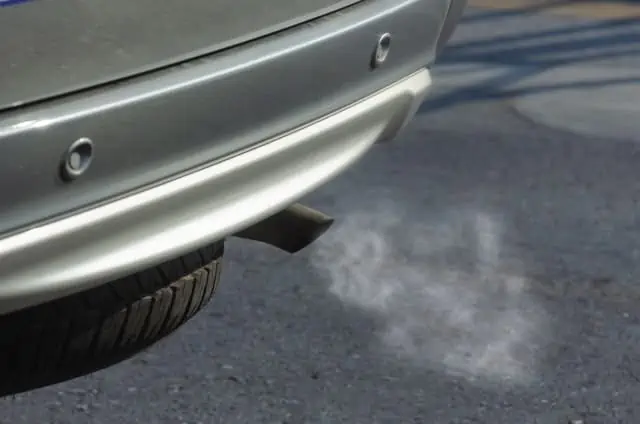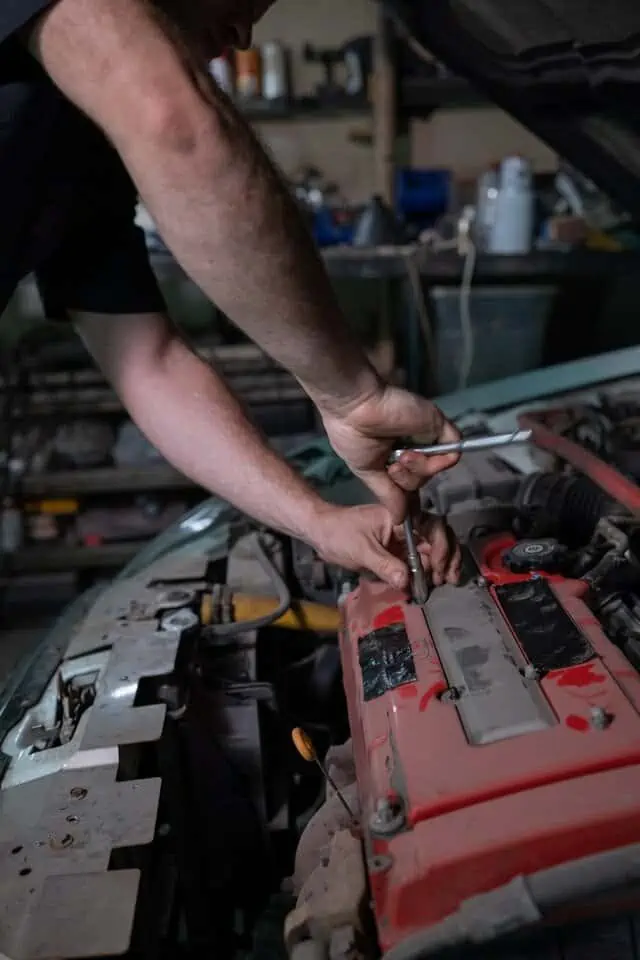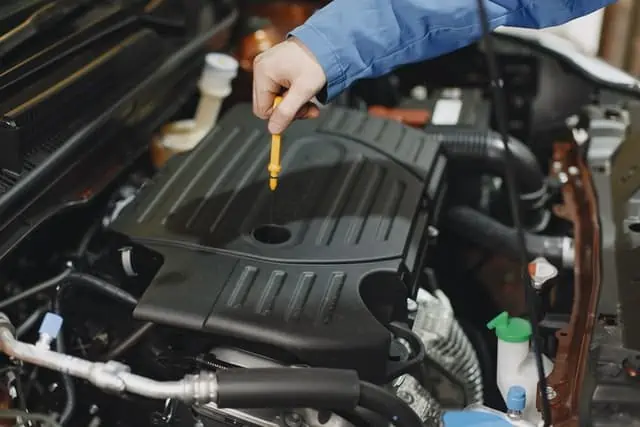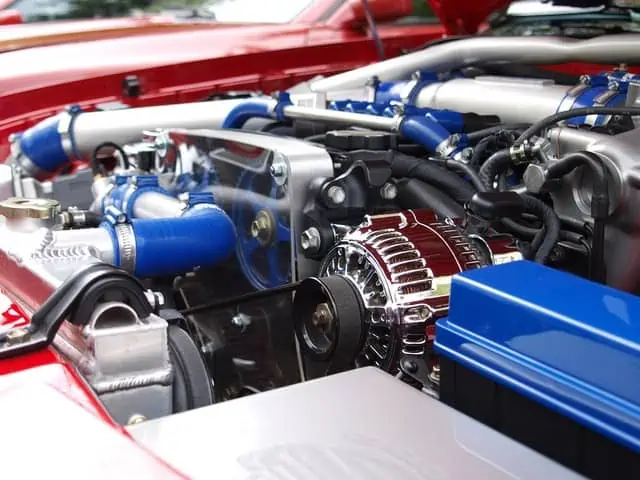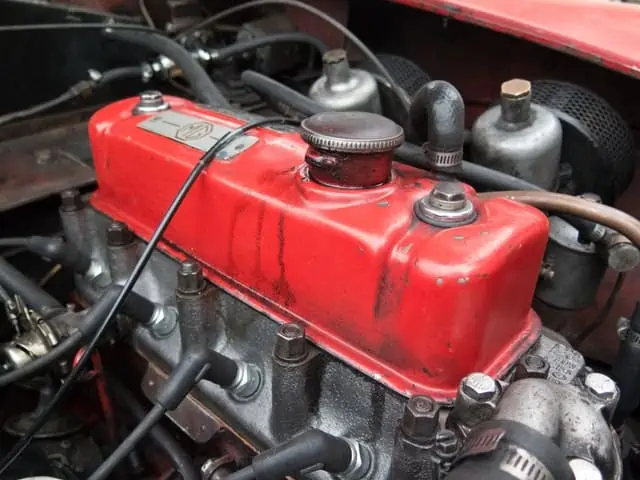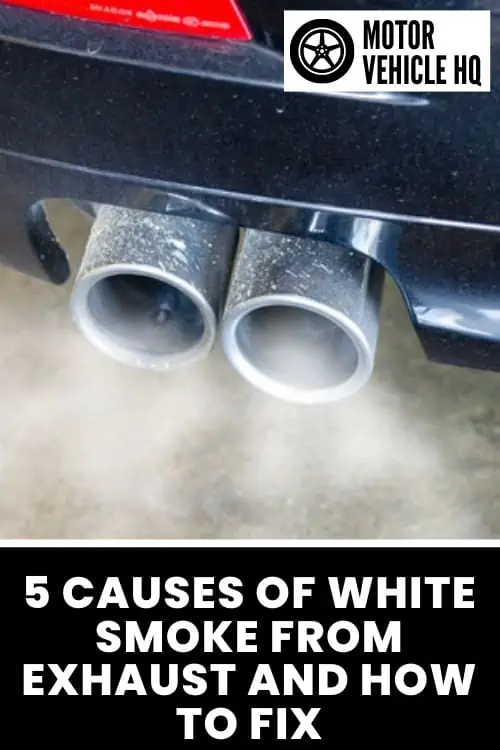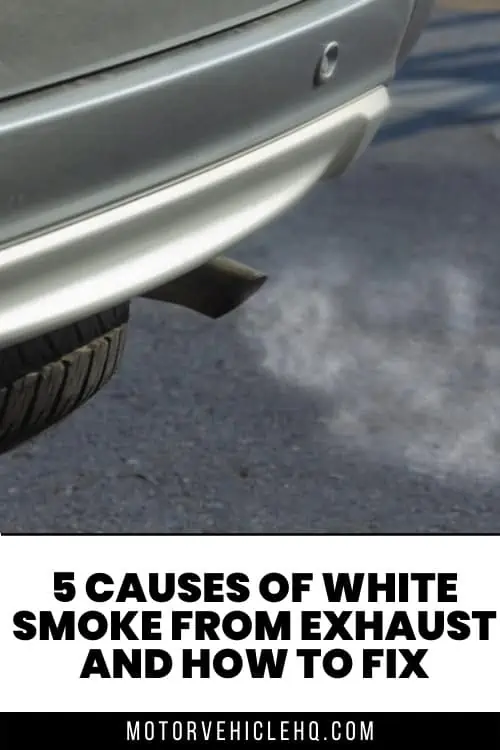The exhaust fumes that come out of your tailpipe are the direct byproduct of the combustion process that takes place in your engine. The gases pass through the exhaust system down a catalytic converter to reduce harmful emissions and then through the muffler to reduce noise.
Under normal conditions, the exhaust fumes from your tailpipe shouldn’t be visible. Occasionally, your car emits light white smoke, which is just water vapor. However, when you notice dense white smoke coming from your exhaust, it is a clear sign that something is wrong and ignoring it could put your engine at serious risk of damage.
Whether it is white smoke from exhaust while accelerating or white smoke from exhaust on startup, you should immediately go to a repair shop for an inspection. Several causes can be linked to this problem, but this article will be discussing five leading causes of white smoke from exhaust and how to fix them.
First, understand your car’s mechanics.
Understanding the mechanics of the exhaust system would help every car owner know what’s worth and what is not worth their worry. The fumes generated by your vehicle’s exhaust systems are by-products of the engines’ internal combustion.
A catalytic converter makes these fumes less harmful, and a muffler reduces the accompanying noise from the exhaust. Based on these mechanics, you should never have to see the fumes coming out from the exhaust of your vehicle.
There are various colors of smoke emitted by your exhaust when there’s a mechanical problem. Depending on the problem, you may see white, blue, grey, or black smoke from your exhaust.
Each of these colors is symbolic of a possible problem with your vehicle.
Various Car Smoke Colors
Before we dive into white smoke, you can learn a thing or two about other smoke colors.
There are varying colors of smoke you might see from the exhaust of your car. Asides from white smoke, you could observe black or blue smoke. Black smoke indicates a problem with your fuel system, and you’d be burning more fuel than usual when your exhaust emits black smoke.
Blue smoke, on the other hand, indicates that your car is burning more oil than usual. The moment you observe blue smoke, keep track of your oil consumption, and top the oil regularly. If the damage makes way to the combustion chamber and Is extensive, you’d have to spend significantly on repairing the leakage and other damaged parts.
Gray smoke from your car’s exhaust could mean that your PCV valve has failed or there’s excess oil in your car. If your car is an automatic car, the odds exist that one of your transmission fluid is leaking. A bad turbo charger can also cause grey smoke from your exhaust.
Types of White Smoke
For starters, the car exhaust ensures that harmful gases from your car engines are safely released. They are your “car lungs.” Generally, white smoke being released from the car exhaust can be classified into two:
Thin White Smoke
Suppose you have experienced thin white smoke from your exhaust, especially during cold seasons like winter, that is perfectly normal and not a reason to worry.
Thick White Smoke
Unlike thin white smoke, thick white smoke from the exhaust indicates some function failure that requires immediate repairs or replacement of faulty parts. If you continue to drive the car in that state, you will risk costly and severe damage to your car engine.
Thick white smoke from exhaust might indicate that coolant or water has unintentionally entered the combustion chamber (an enclosed space in the car where air and fuel mixture is burned), which they should never have. When water or coolant has burned within the engine block (a part of the internal combustion engine), it produces thick white smoke that leaves through the exhaust.
What does white smoke from the exhaust say about your car?
White smoke from your car exhaust means water/coolants have found their way to the combustion chamber of your engine.
You’re at risk of overheating or worse, damage to your vehicle if you do not diagnose and fix the possible issues with your car. Overheating would ultimately damage the engine of your vehicle.
Diagnosing the exact reason for white smoke from your exhaust is subject to the prevailing conditions. Standardly, you see white smoke from your car’s exhaust when there’s a faulty head gasket, a crack in the head or engine.
To determine if you’re dealing with a faulty head gasket or engine crack, check your car’s coolant level. If it’s low and you can’t trace any leakage points, you would need to make some major repairs ASAP.
Possible causes of white smoke from exhaust
As discussed in the previous section, the standard diagnosis would be a faulty head gasket, a crack in the head or engine.
Subsequently, we will discuss the possible causes in detail.
#1 – Condensation in the Tailpipe
One of the most common causes of white smoke from exhaust isn’t actually smoke at all but simply condensation in the tailpipe. This is a regular occurrence during colder months or in colder climates. It is a widespread phenomenon for persons who have lived in a warm climate and then relocated to a colder region.
When a cold engine is started, it soon begins to heat up and thus produces water vapour as a by-product. This process creates condensation within the exhaust system, and as the temperature increases within the engine, steam is released from the tailpipe which takes the form of smoke coming out of the exhaust.
How to Fix
Condensation in the tailpipe is a perfectly normal and harmless phenomenon, so if you’re experiencing this problem, there’s no need to worry. Once the car has warmed up or after you drive around for a while, the steam will evaporate.
#2 – Coolant Leak
A coolant leak is a common cause of white smoke from exhaust. It typically occurs when there is a crack in the cylinder head or the engine block. It could also occur when there is a crack in the coolant reservoir tank although this is rare.
When cracks occur in these parts, it is usually caused by a consistently overheating engine due to low coolant levels and constant changes in the temperature of the engine. The crack causes the coolant to seep and go into the combustion chamber, contaminating the engine oil.
The crack doesn’t necessarily have to be a big one; all it takes is a tiny crack to create thick bursts of white smoke from your exhaust. The mixture of the coolant and engine oil in turn produces a white smoke with a milky appearance. When you notice consistent white smoke billowing out from your exhaust pipe with a distinct sweet-smelling odor, it usually indicates a problem with your coolant leaking.
If the coolant reservoir tank is punctured or cracked, it can also cause coolant to leak into the engine’s combustion chamber. When this leaking coolant gets into the cylinders, it gets burned and creates thick white smoke from exhaust.
Coolant leak from a punctured coolant reservoir tank is not a very common problem, but it can happen when you are repairing another problem close to it and accidentally damage the tank. Whatever the case, you will need to replace the damaged reservoir tank.
In the worst-case scenario, the entire engine block may have a crack in it. If this happens, then you should brace up for a costly and time-consuming replacement. You will most likely need the services of a professional mechanic in this case.
Most engine blocks are made from either cast-iron or aluminum alloy, to ensure their durability and resistance to high-heat conditions. They are also designed to make sure that they effectively transfer heat away from the engine.
However, a motor vehicle’s engine is a complex and interdependent system that requires all of its components to work with absolute precision. In the event that any of the engine’s components fails or isn’t working as it is supposed to, the block can overheat and begin to weaken and deteriorate.
In addition to white smoke coming from the exhaust, there are a few other signs that indicate your block may be getting too hot. You may begin to notice puddles of fluid under your car, discolored coolant, and frozen coolant in the radiator. Also, expect to experience poor performance because the engine will be unable to maintain adequate compression if there’s a leak in the combustion chamber.
How to Fix
When fixing a coolant leakage, the first step is to examine the cylinder head and the intake manifold gasket. The cylinder head links the engine block and head gasket and is one of the main components of a vehicle’s engine. It is usually susceptible to warping or cracking due to overheating and should be changed promptly if any cracks or fractures are discovered.
The same approach applies to the intake manifold gasket, which is responsible for transporting oxygen and coolant to the car’s engine. It should be examined before the head gasket and replaced if it forms a crack.
Repairing a cracked cylinder head will cost between $500-$1,000 depending on whether it’s cast iron or aluminium. Cracks in cast iron cylinder heads can often be fixed by flame spray welding or furnace welding. If the crack cannot be fixed, then the entire cylinder head will need to be replaced.
While replacing a cracked cylinder head may not be too difficult a job for the experienced mechanic, it is an extremely time-consuming task. This is mainly because the engine head has to be removed before it is replaced, thus a good portion of the replacement cost goes into labor costs.
Another thing to note is that the labor costs vary to a large extent depending on the make and model of your car. Luxury cars such as Audis and BMWs often require the removal of various other components before getting to their cylinder heads, all of which add to the labor cost. The average cost for cylinder head replacement is between $2,800 and $3,200. Labor costs are estimated between $1,200 and $2,700 while parts cost only anywhere from $200 to $500.
#3 – Piston Ring or Valve Seal Leak/Oil in the Combustion Chamber
Another probable cause of white smoke from exhaust is leaking valve seals or piston rings. Piston rings and valve seals are prone to wear and tear. When a valve seal or piston ring gets worn out, it begins to crack and causes oil to leak into the combustion chamber.
The only thing that should be in a combustion chamber is air and fuel. So if oil happens to flow inside, you can be sure that there will be a problem. The oil will inevitably mix with the fuel and burn, resulting in a blanket of thick white smoke coming out of your tailpipe.
How to Fix
If oil is seeping into your vehicle’s combustion chamber, it means the oil is missing in areas where it should be. When different engine components aren’t receiving enough oil, it can lead to a host of other problems and should therefore be addressed immediately. Resolving this problem will require replacing the broken piston rings or valve seals. One way to preserve piston rings from getting worn out too soon is to switch to high-mileage motor oil.
Just like piston rings replacement, the process of replacing valve seals involves disassembling the entire engine to the point where you are able to reach the valve spring. Unless you are very knowledgeable about disassembling engines, it is best to leave this job to a professional mechanic to handle.
Replacing piston rings is very costly, usually ranging between $1,800 to $3,500, of which the parts only go for about $75-$200 while the rest is for labor, since it is an extremely time-consuming task.
#4 – Bad Fuel Injector
A fuel injector is a spray nozzle that transports fuel to the combustion chamber as input for the combustions. Although it does not regulate how much fuel gets sent, it can allow or restrict its passage. It just injects the fuel at the right time. It has been expertly programmed to function this way for optimal combustion within the engine’s chamber, and any slight variation can disrupt the entire system.
When a fuel injector develops a fault – usually when it gets stuck in an open position, leaks from the o-ring, or malfunctions in any way – it will no longer transport the right amount of fuel to the combustion chamber at the right time. Too much fuel in the engine cannot burn properly and will let out thick white smoke from your exhaust.
There’s also the possibility that your fuel injectors are clogged. Fuel injectors are generally susceptible to getting clogged by carbon deposits and sludge formation. Fortunately, there are commercial fuel injector cleaners that you can use to clear a dirty fuel injector.
Other signs that indicate you might have a faulty fuel injector include:
- Throttle surges
- Reduced performance
- Poor fuel economy
- Poor idle
- Rough performance
- Reduced RPM limit
- Trouble starting
How to Fix
When a fuel injector develops a fault, it most likely means it has outlived its purpose. Faulty fuel injectors cannot be fixed; therefore, they need to be replaced. When replacing a faulty fuel injector, you should always ensure that you replace the entire set instead of only replacing the problematic one. Otherwise, the engine will not run evenly.
It’s not advisable to inspect the injection or attempt to change it by yourself, as it is a task that is best left to a professional mechanic service. The reason that fuel injectors fail is mainly because of contaminants in the fuel. The best way to avoid this is to replace the fuel filter routinely, at least every two years.
#5 – Incorrect Injector Pump Timing (Diesel Specific Engines)
If your engine runs on diesel and you notice white smoke coming from your exhaust, it could likely be due to an issue with the injector pump timing. An injector pump of a diesel engine needs to be precisely timed. The injector pump is responsible for supplying the cylinders with diesel.
Like with the fuel injector in a gas-powered engine, if the timing of the pump is off and diesel is not delivered to the engine’s chamber at the precise time, it will lead to an overrun of diesel into the cylinders, which will cause a thick white smoke from the exhaust.
Other signs of injector pump failure include poor idle, trouble starting, reduced performance, reduced RPM limit, rough rides and poor fuel economy.
How to Fix
Sometimes the white smoke from exhaust could be because the timing of the injector pump is turned off. If this is the case, all you need to do is to reprogram the ECM. If that doesn’t resolve the issue, you will need to buy a new pump entirely.
The average cost for a fuel pump replacement ranges from $220 to $1,100 depending on the make and model of the vehicle. Labor costs range from $120 to $260, while parts cost between $90 to $860.
Another option you can try is to replace the camshaft, which typically costs between $1,500 to $3,000. Note that these tasks are not to be attempted by inexperienced persons, as they require tools and knowledge that only a certified mechanic would have.
After the replacement has been carried out, try to avoid fuel injector pump failure caused by contaminants in the diesel. Replace the diesel fuel filter regularly to prolong the life of the injector pump, and only fill your tank at prestigious refill stations where they sell the highest quality of diesel.
Cracked Head Gasket
The head gasket is an adhesive between the engine block and cylinder head. It is a barrier between engine oil, combustion, and the coolant. Thus, it helps prevent fluid engine leaks and pressure losses.
Engine coolant is mostly water, so when coolant is burned in the engine, water vapor will come out of the exhaust as thick white smoke. This indicates that the engine has consumed coolant due to a cracked head gasket. It would help your diagnosis to check out other signs of a cracked head gasket.
Cracked Engine Block
Engine blocks are mostly produced from either cast-iron metal or aluminum alloy, making them durable in constant heating conditions. There are very few cases of cracked engine blocks because damages occur in the head gasket before getting to the engine block.
However, the engine is a complex system that requires every component to function precisely. Suppose any engine components aren’t working as they should, it could cause the engine block to overheat and possibly crack, resulting in thick white smoke from the exhaust.
Bad Fuel
Low-octane fuel could be one of the reasons why your gas head blows up, causing thick white smoke. In other cases, bad fuel could successfully crack the cylinder head of some engines. By default, bad fuel harms these cylinders by pushing them beyond their limit and causing a crack.
The damage occurs as a pre-ignition in the combustible chamber that increases pressure and damages the cylinder/gasket. Other factors that contribute to pre-ignition combustion include; advanced ignition timing or an old engine with ring wear that allows contact between oil blow-by and air/fuel charge.
Faulty 02 Sensors
Fuel-injected cars have oxygen sensors attached to the exhaust system. They are designed to regulate how much fuel is injected into the engines at a time. If vaporized antifreeze or coolants come in contact with your oxygen sensors, it can cause white fumes from your tailpipes.
When these coolants contact your oxygen sensors, they stop working, and a fault code appears. A prompt to check your engine from the dashboard should notify you of this damage. Changing the oxygen sensors would fix the glitch when you ascertain this as the cause of white fumes.
Engine Control Unit (ECU) Error
The engine control unit manages all the engine components and implements necessary actions. If there is a malfunction in the Engine Control Unit, the timing of fuel injectors might be imbalanced, causing white smoke from your car exhaust.
Buying a new engine or rebuilding your engine is one of the risks associated with persistent white fumes from your tailpipes. This does not mean the fuel injector is bad. It only means the engine control unit needs a reconfiguration to adjust the timing of the fuel injector.
Confirming the cause of white smoke from your exhaust
Usually, many vehicle owners find it hard to troubleshoot which of the many causes is the exact reason for white fumes from your tailpipes.
Although diagnosis is the mechanic’s job, it would help if you knew some bits and pieces. Sometimes, it saves you from novice or unnecessary expenses.
Certain defects in the mechanical components of your car can help you ascertain that a blown out head gasket is the cause of white smoke from your exhaust system. These defects include
- Foam in the engine oil,
- Foam in the coolant,
- Overheating and
- Air in the cooling system.
All or some of these mechanical defects co-occurring means that a blown gasket head is likely the cause of white smoke from your exhaust.
If you suspect that the coolant entering the engine block is the cause of the white smoke, you should check the level of the coolant. Identifying a coolant leak is pretty difficult to do on your own. You can buy a block tester to aid your diagnosis.
If the coolant level is low and there are no other signs of leakage, the problem may be caused by a crack in the head gasket, cylinder head, or engine block.
Conclusion
White smoke from exhaust can mean many things and it is a common issue that will affect every vehicle at some point. While it may be a harmless phenomenon in many cases, it is sometimes a clear indication of an underlying malfunction in your vehicle. So in a case where you notice white smoke from the exhaust when idle or accelerating, applying the recommendations outlined above will give you a better shot at dealing with the problem successfully.

Jim Wicks is the founder of MotorVehicleHQ. With over two decades of experience in the automotive industry and a degree in Automotive Technology, Jim is a certified car expert who has worked in various roles ranging from a mechanic, car dealership manager, to a racing car driver. He has owned more than 20 cars over the past 15 years. Ask him about any vehicle you see on the road and he can tell you the make, model and year. He loves the aesthetics of all things cars, and keeps his vehicles in pristine condition.
In his free time, Jim enjoys getting his hands dirty under the hood of a classic car or taking long drives along the country roads. His favorite car? A 1967 Shelby GT500, a true classic that, according to Jim, “represents the pure essence of American muscle.”
